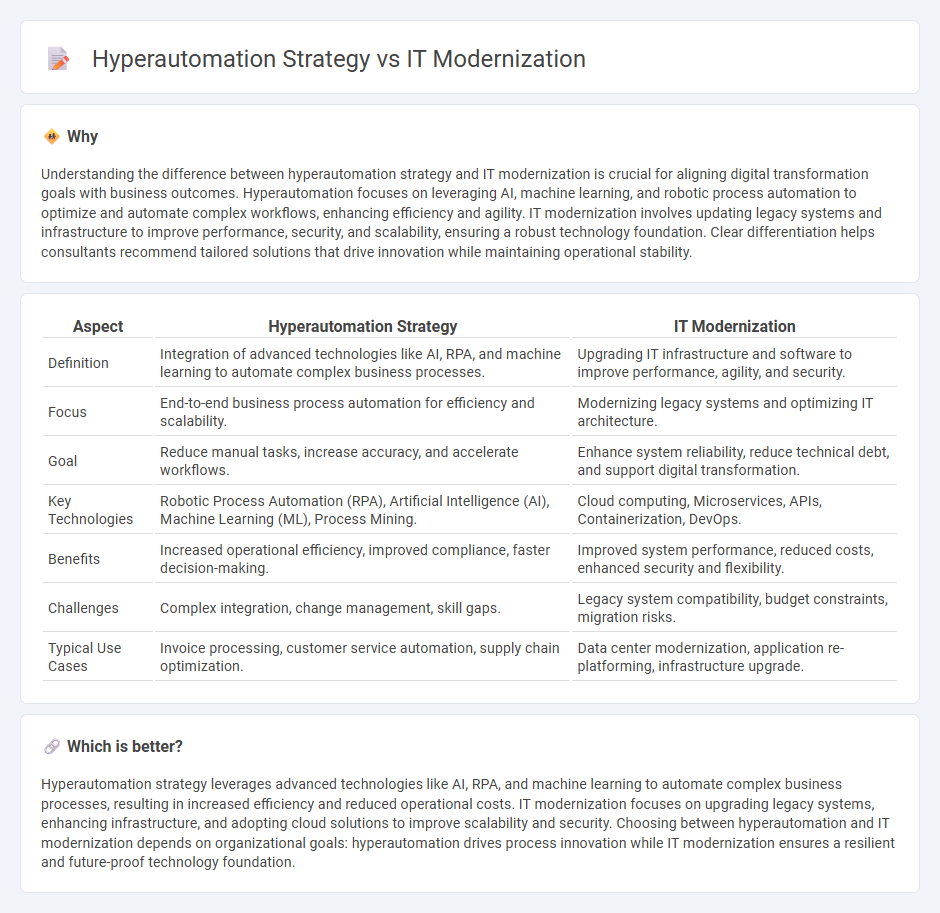
Hyperautomation strategy leverages advanced technologies like AI, machine learning, and robotic process automation to streamline complex business processes and drive digital transformation efficiently. IT modernization focuses on upgrading existing infrastructure, software, and platforms to improve performance, scalability, and security. Explore the differences and benefits of these approaches to determine the best fit for your organization's growth.
Why it is important
Understanding the difference between hyperautomation strategy and IT modernization is crucial for aligning digital transformation goals with business outcomes. Hyperautomation focuses on leveraging AI, machine learning, and robotic process automation to optimize and automate complex workflows, enhancing efficiency and agility. IT modernization involves updating legacy systems and infrastructure to improve performance, security, and scalability, ensuring a robust technology foundation. Clear differentiation helps consultants recommend tailored solutions that drive innovation while maintaining operational stability.
Comparison Table
| Aspect | Hyperautomation Strategy | IT Modernization |
|---|---|---|
| Definition | Integration of advanced technologies like AI, RPA, and machine learning to automate complex business processes. | Upgrading IT infrastructure and software to improve performance, agility, and security. |
| Focus | End-to-end business process automation for efficiency and scalability. | Modernizing legacy systems and optimizing IT architecture. |
| Goal | Reduce manual tasks, increase accuracy, and accelerate workflows. | Enhance system reliability, reduce technical debt, and support digital transformation. |
| Key Technologies | Robotic Process Automation (RPA), Artificial Intelligence (AI), Machine Learning (ML), Process Mining. | Cloud computing, Microservices, APIs, Containerization, DevOps. |
| Benefits | Increased operational efficiency, improved compliance, faster decision-making. | Improved system performance, reduced costs, enhanced security and flexibility. |
| Challenges | Complex integration, change management, skill gaps. | Legacy system compatibility, budget constraints, migration risks. |
| Typical Use Cases | Invoice processing, customer service automation, supply chain optimization. | Data center modernization, application re-platforming, infrastructure upgrade. |
Which is better?
Hyperautomation strategy leverages advanced technologies like AI, RPA, and machine learning to automate complex business processes, resulting in increased efficiency and reduced operational costs. IT modernization focuses on upgrading legacy systems, enhancing infrastructure, and adopting cloud solutions to improve scalability and security. Choosing between hyperautomation and IT modernization depends on organizational goals: hyperautomation drives process innovation while IT modernization ensures a resilient and future-proof technology foundation.
Connection
Hyperautomation strategy accelerates IT modernization by integrating advanced technologies like artificial intelligence, machine learning, and robotic process automation to streamline and optimize complex business processes. IT modernization provides the necessary infrastructure and updated systems that enable seamless deployment of hyperautomation tools, enhancing operational efficiency and agility. Together, they drive digital transformation by reducing manual tasks, improving data accuracy, and delivering faster decision-making capabilities.
Key Terms
Legacy Systems Migration
Legacy systems migration plays a critical role in IT modernization by enabling organizations to update outdated infrastructures and reduce operational costs effectively. Hyperautomation strategy complements this by integrating advanced technologies like AI and RPA to streamline workflows and enhance system interoperability. Explore how combining IT modernization with hyperautomation accelerates digital transformation and drives business agility.
Robotic Process Automation (RPA)
IT modernization emphasizes upgrading legacy systems to cloud-based, scalable infrastructure, enhancing security and performance to support digital transformation. Hyperautomation strategy leverages Robotic Process Automation (RPA) to automate repetitive tasks, integrating AI and machine learning for end-to-end process efficiency and agility. Explore how combining IT modernization with hyperautomation and RPA can revolutionize your business operations.
Cloud-Native Architecture
Cloud-native architecture drives IT modernization by leveraging microservices, containers, and dynamic orchestration to enhance scalability, agility, and resilience. Hyperautomation strategy complements this by integrating advanced AI, machine learning, and RPA to streamline processes and optimize cloud environments. Explore how combining cloud-native architecture with hyperautomation can accelerate your digital transformation journey.
Source and External Links
What is IT Modernization?: Definitions and Examples - Talend - IT modernization is the process of moving from legacy systems to a modern IT operating model through aligning IT with business goals, simplifying infrastructure, modernizing applications, and securing operations in hybrid environments.
What Is IT Modernization? | Definition from TechTarget - IT modernization updates an organization's IT infrastructure and practices with emerging technologies like AI and cloud, improving agility, reducing downtime, and enhancing collaboration to stay competitive and achieve business goals.
What is IT modernization? - Red Hat - IT modernization updates outdated infrastructure using solutions like Red Hat Enterprise Linux, OpenShift, and Ansible Automation to enable cloud-native development, IT automation, integrated security, and workforce skill-building for future business needs.
 dowidth.com
dowidth.com